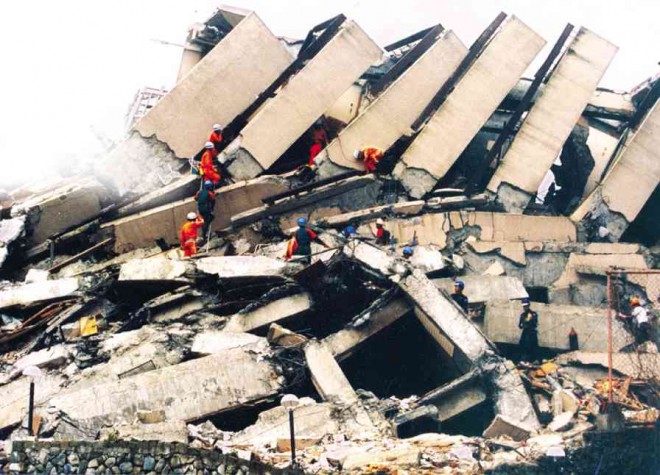Baguio shares lessons on rising from disaster

THE TOPPLED Hyatt Terraces Hotel in Baguio City, which crumbled after a 7.7-magnitude earthquake rocked the summer capital 24 years ago, serves as a grim reminder of the power of nature. INQUIRER FILE PHOTO
Natural disasters like the July 16, 1990, killer earthquake in Luzon still serve as object lessons on how best to recover from a devastation, which many assumed had ended their world.
Baguio old-timers, who survived the temblor 24 years ago, said all it took was 54 seconds for their lives to crumble. The 7.7-magnitude quake shook the city at 3:26 p.m. (4:26 p.m., Daylight Savings Time), the direct result of the movement of the Digdig Fault in Nueva Ecija and Nueva Vizcaya provinces.
It was followed quickly by another ground shaking, some 20 kilometers northeast of Baguio.
Initially, the shell-shocked city residents were told that 399 of their neighbors and 244 others in nearby towns in Benguet province were killed when homes, buildings and mountain roads collapsed. The numbers soon rose to more than 1,000. Stories about unclaimed bodies buried in the mountains still linger today.
More than 20,000 houses were destroyed or condemned in Baguio and Benguet. Buildings left standing could not be trusted for safety or structural integrity. By August 1990, the city and provincial governments were confronted by over P10 billion in damage to buildings, schools, hospitals, roads, bridges, and power and water facilities. The national government could only shoulder less than a quarter of the rehabilitation costs.
Article continues after this advertisementJoseph Alabanza, former city architect, said the most heartbreaking consequence of the quake was the exodus of people. Both migrants and old families were convinced that the city had died, he said, so they resolved to begin new lives elsewhere. Baguio was isolated for a time so some families actually hiked down to the lowlands.
Article continues after this advertisementRebuilding quickly
“That’s lesson number one. Rebuilding quickly became the community’s most important task,” he said. “A lot of people left. We needed everything up again and fast before opportunity was lost.”
Alabanza was Cordillera regional director of the National Economic and Development Authority at the time, so he convened the line agencies to draw up the first version of BLIST (a social and economic cooperative to be composed of Baguio and the towns of La Trinidad, Itogon, Sablan and Tuba), which would spread out investments from the city to the outlying municipalities.
The local government cooperative (which has evolved to include Tublay town) would decongest the summer capital, by helping its neighbors develop housing subdivision projects, industrial zones and schools.
Baguio-based nongovernment organizations and businessmen also convened an NGO Congress, which drafted for the government a common framework for building a new city. It was so detailed that it even provided a wish list of how the city’s garbage was to be collected daily.
Alabanza said the congress was the second major lesson for reconstruction: “The private sector and the public were necessary to reconstituting Baguio quickly.”
Creative
The city also became creative. Panagbenga, the tourist-drawing Baguio Flower Festival, was popularized by administrators of Camp John Hay to help draw back tourists, said lawyer Damaso Bangaoet Jr., the event’s acknowledged architect.
But sometimes speed itself became a problem. Many newspaper accounts in 1990 discussed “shortcuts” and “emergency measures” to quicken restoration that were of “questionable wisdom.”
For example, the city council of that period imposed a moratorium on the prerequisite of securing building permits to allow residents to rebuild their homes quickly. However, it had not taken into account the proliferation of squatters.
Like some of the accounts in the Visayas shortly after communities there were devastated by Supertyphoon “Yolanda” last year, the 1990 devastation overwhelmed Baguio’s leadership so much that it became indecisive.
Don’t lose control
For a time, the national government called the shots at keeping order in the city, which provided the more aggressive politicians a platform for photo opportunities at the expense of rescue efforts.
Alabanza said the last lesson was one even the city needed to reflect upon today: “Don’t lose control.”
Massive urbanization now makes commuters wake up much earlier to travel 20 minutes more to work or school in the downtown area. Last year, traffic jams were attributed to the 46,848 registered vehicles that drove through narrow roads at one time or another, said Robert Pocais, regional operations chief of the Land Transportation Office.
A little more than 6,000 of the vehicles are public utility vehicles, according to LTO records. It said 10 percent (40,069) of the 400,000 daytime population, including transients, own vehicles and could be motoring in each day.
That many vehicles tax the national roads, which span 111 kilometers in a 57 sq. km radius, said Ireneo Gallato, city district engineer. Many of the roads are no wider than 6.10 meters.
Buildings have also become higher than usual, Alabanza said.